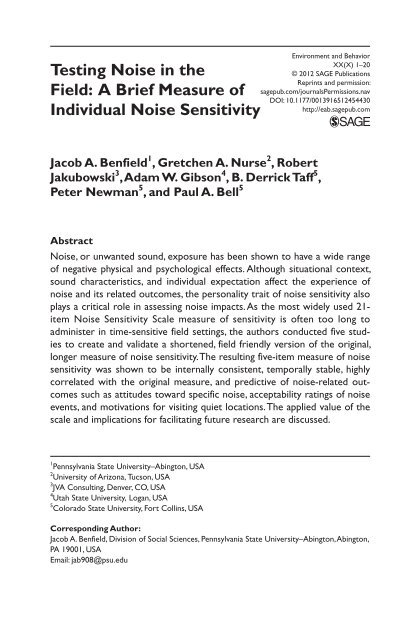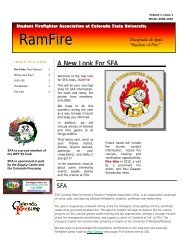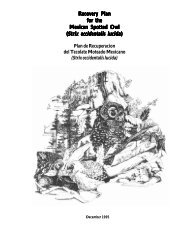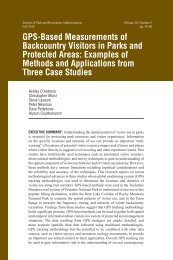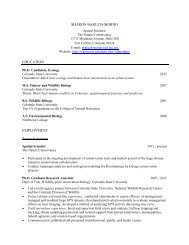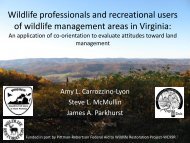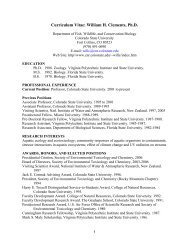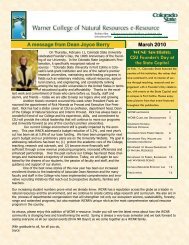Benfield, J.A., Nurse, G.A., Jakubowski, R., Gibson, A., Taff, D ...
Benfield, J.A., Nurse, G.A., Jakubowski, R., Gibson, A., Taff, D ...
Benfield, J.A., Nurse, G.A., Jakubowski, R., Gibson, A., Taff, D ...
You also want an ePaper? Increase the reach of your titles
YUMPU automatically turns print PDFs into web optimized ePapers that Google loves.
454430EABXXX10.1177/00139165124544<br />
30Environment and Behavior<strong>Benfield</strong> et al.<br />
© 2012 SAGE Publications<br />
Reprints and permission:<br />
sagepub.com/journalsPermissions.nav<br />
Testing Noise in the<br />
Field: A Brief Measure of<br />
Individual Noise Sensitivity<br />
1 Pennsylvania State University–Abington, USA<br />
2 University of Arizona, Tucson, USA<br />
3 JVA Consulting, Denver, CO, USA<br />
4 Utah State University, Logan, USA<br />
5 Colorado State University, Fort Collins, USA<br />
Environment and Behavior<br />
XX(X) 1 –20<br />
© 2012 SAGE Publications<br />
Reprints and permission:<br />
sagepub.com/journalsPermissions.nav<br />
DOI: 10.1177/0013916512454430<br />
http://eab.sagepub.com<br />
Jacob A. <strong>Benfield</strong> 1 , Gretchen A. <strong>Nurse</strong> 2 , Robert<br />
<strong>Jakubowski</strong> 3 , Adam W. <strong>Gibson</strong> 4 , B. Derrick <strong>Taff</strong> 5 ,<br />
Peter Newman 5 , and Paul A. Bell 5<br />
Abstract<br />
Noise, or unwanted sound, exposure has been shown to have a wide range<br />
of negative physical and psychological effects. Although situational context,<br />
sound characteristics, and individual expectation affect the experience of<br />
noise and its related outcomes, the personality trait of noise sensitivity also<br />
plays a critical role in assessing noise impacts. As the most widely used 21item<br />
Noise Sensitivity Scale measure of sensitivity is often too long to<br />
administer in time-sensitive field settings, the authors conducted five studies<br />
to create and validate a shortened, field friendly version of the original,<br />
longer measure of noise sensitivity. The resulting five-item measure of noise<br />
sensitivity was shown to be internally consistent, temporally stable, highly<br />
correlated with the original measure, and predictive of noise-related outcomes<br />
such as attitudes toward specific noise, acceptability ratings of noise<br />
events, and motivations for visiting quiet locations. The applied value of the<br />
scale and implications for facilitating future research are discussed.<br />
Corresponding Author:<br />
Jacob A. <strong>Benfield</strong>, Division of Social Sciences, Pennsylvania State University–Abington, Abington,<br />
PA 19001, USA<br />
Email: jab908@psu.edu
2 Environment and BehaviorXX(X)<br />
Keywords<br />
noise, personality, environmental stressor, noise sensitivity, recreation<br />
Unwanted sound, or noise, is considered one of the most ubiquitous of ambient<br />
environmental stressors. Noise generated by transportation, workplace<br />
technology, and other humans has been shown to be detrimental in a number<br />
of ways. For example, the presence of unwanted sounds has been related to<br />
higher stress levels (e.g., Ising & Kruppa, 2004), increased cognitive errors<br />
(e.g., <strong>Benfield</strong>, Bell, Troup, & Soderstrom, 2010b; Stansfeld et al., 2005),<br />
reduced health and well-being (e.g., Stansfeld & Matheson, 2003), disturbances<br />
in sleep cycles (e.g., Muzet, 2007), negative changes in affect (e.g.,<br />
<strong>Benfield</strong>, Bell, Troup, & Soderstrom, 2010a; Mace, Bell, & Loomis, 1999),<br />
and lower amounts of prosocial behaviors (e.g., Moser, 1988). Increasingly,<br />
scientists are recognizing the physical health consequences of noise (e.g.,<br />
Babisch, 2006; Fritschi, Brown, Kim, Schwela, & Kephalopoulos, 2011) and<br />
consequently adding “harmful” to its definition (e.g., “unwanted or harmful<br />
sound”). In doing so, they embrace beliefs that noise can be measured not just<br />
as a subjective annoyance but as an objective harm quantifiable by its health<br />
consequences across populations or by a “reasonable person” standard of<br />
assessment. In short, exposure to noise is a problem physiologically and psychosocially,<br />
so understanding the components of noise and psychological perceptions<br />
of noise as they relate to these outcomes is important.<br />
Different theoretical perspectives have been used to explain the process<br />
underlying these negative effects, but most rely heavily on the interaction<br />
between the physical sound stimuli and the perceiver of the sound. For<br />
instance, arousal and stress perspectives posit that noxious sound increases<br />
negative affect, generalized anxiety, and frustration in the listener, which in<br />
turn causes stress and/or arousal with subsequent changes in blood pressure,<br />
sleep patterns, immune functioning, and hormone levels (Cohen, Evans,<br />
Stokols, & Krantz, 1986). In these models, the individual’s reaction to the<br />
sound (e.g., annoyed, frustrated) drives the negative consequence rather<br />
than the sound itself. Similarly, sounds that are perceived as unnecessary or<br />
detrimental to something the listener values are more annoying and psychologically<br />
damaging. The same is true of noises that are considered by the<br />
perceiver to be hazardous to his or her health (Green & Fidell, 1991). Noise<br />
generated by someone seemingly unconcerned with the listener’s well-being<br />
is also evaluated negatively (Miedema & Vos, 1999). In short, people are<br />
generally motivated to avoid noise, but individual differences in listeners
<strong>Benfield</strong> et al. 3<br />
and their perceptions of the stimuli contribute heavily to noise-induced outcomes<br />
and experiential reports of noisy environments.<br />
Examples of these individual differences in sound and noise perception<br />
are numerous. For instance, individuals trained in music or singing respond<br />
differently when compared with novices (Williams, 2005). Similarly, military<br />
combat veterans can be hypersensitive to the holiday sights and sounds<br />
of New Year’s eve (e.g., flashing lights, loud explosions) because similar<br />
stimuli have become associated with mortal danger (Chemtob, Roitblat,<br />
Hamada, Carlson, & Twentyman, 1988). More generally, the rumbling of a<br />
thunderstorm can be an exciting and pleasant experience to some but terrifying<br />
or depressing to another. Likewise, a parent trying to lull a newborn to<br />
sleep or a night shift worker trying to rest during the day perceives bird<br />
chirps, garbage trucks, and telephone rings differently from those who are<br />
currently less motivated for quiet conditions.<br />
Given the definition of noise (i.e., unwanted or harmful sound), an emphasis<br />
on the perceiver and his or her individual perceptions or traits makes sense<br />
if researchers want to truly differentiate between effects caused by the sound,<br />
effects caused by the listener, and effects that depend on the interaction<br />
between the two. Consequently, individual differences are often tested and<br />
controlled for in sound-related research to partial out which effects are universal<br />
and which are more person dependent.<br />
Individual Differences in Noise Sensitivity<br />
For example, the Big Five personality characteristics of extraversion and<br />
neuroticism have been shown to affect participant perceptions of and performance<br />
during exposure to noise. Extraversion—the tendency to be gregarious,<br />
be assertive, and seek out social stimulation—has been shown to be<br />
related to preference for greater sound intensity (Geen, 1984) and reduced<br />
distraction by extraneous noise (Belojevic, Slepcevic, & Jakovljevic, 2001;<br />
Daoussis & McKelvie, 1986; Furnham, Gunter, & Peterson, 1994). Likewise,<br />
neuroticism—the tendency to be anxious, emotionally negative, and less<br />
emotionally stable—has also been shown to be positively correlated with<br />
annoyance during noise exposure (Öhrström, Bjorkman, & Rylander, 1988)<br />
and with noise-induced sleep disturbances (Jakovljevic, Belojevic, Paunovic,<br />
& Stojanov, 2006). Neurotics when compared with more emotionally stable<br />
individuals also perform worse on semantic retrieval tasks (von Wright &<br />
Vauras, 1980) and prose memorization tasks (Nurmi & von Wright, 1983)<br />
under noisy conditions.
4 Environment and BehaviorXX(X)<br />
Aside from the previously mentioned personality variables, one individual<br />
difference has been particularly salient in research on noise-related<br />
outcomes. Noise sensitivity refers to an individual aversion toward and/or<br />
reactivity to noise and noisy environments (Job, 1999; Weinstein, 1978).<br />
Research on individual noise sensitivity has shown that it is conceptually<br />
distinct from extraversion or neuroticism, uncorrelated with noise exposure,<br />
and largely independent of auditory acuity or function (Ellermeier,<br />
Eigenstetter, & Zimmer, 2001; Job, 1988; Miedema & Vos, 2003; Stansfeld,<br />
Clark, Turpion, Jenkins, & Tarnopolsky, 1985). Higher noise sensitivity is<br />
related to higher skin conductance responses in the presence of noise<br />
(Stansfeld & Shine, 1993), greater reported annoyance (Belojevic &<br />
Jakovljevic, 2001), elevated heart rate (Abel, 1990), sleep loss (Jakovljevic et<br />
al., 2006), psychiatric disturbance (Stansfeld, Clark, Jenkins, & Tarnopolsky,<br />
1985), and slower habituation in the presence of noise (Stansfeld & Shine,<br />
1993). As made obvious by those findings, the inclusion of some form of<br />
measurement for noise sensitivity is paramount to most noise- or soundrelated<br />
studies. Although this is accomplished using several different strategies<br />
ranging from single-item indicators to standardized scales to noise<br />
complaint frequency, some measures have been favored more than others.<br />
The Weinstein (1978) Noise Sensitivity Scale (NSS), developed with a<br />
college student sample, is considered the most well-researched and widely<br />
used formal measure of noise sensitivity (Job, 1999; Miedema & Vos, 2003;<br />
Zimmer & Ellermeier, 1999). It has been shown to be psychometrically valid<br />
(Ekehammar & Dornic, 1990; Zimmer & Ellermeier, 1999) as well as temporally<br />
stable (Stansfeld, 1988; Zimmer & Ellermeier, 1999), and the majority<br />
of the research cited previously used this 21-item instrument.<br />
The Current Studies<br />
As stated previously, noise is an ever-present environmental stressor linked<br />
to a host of adverse effects that manifest themselves to varying degrees<br />
depending on individual differences in the perceiver of the sound. As a<br />
result, characteristics of the listener need to be included in sound research<br />
to allow for clear distinctions to be made between effects caused by the<br />
stimuli and effects facilitated by the individual. Because noise sensitivity<br />
as measured by Weinstein’s (1978) NSS has been shown to be a critical<br />
individual difference factor in the perception of noise and the evaluation of<br />
noise-related outcomes, it should probably be measured in most humanbased<br />
noise research projects. Exploring noise effects in applied research<br />
contexts such as museums and national parks is becoming more common<br />
(e.g., <strong>Jakubowski</strong>, 2011; Pilcher, Newman, & Manning, 2009). As the
<strong>Benfield</strong> et al. 5<br />
compliance rate for agreeing to intercept interviews with participants in<br />
these applied settings declines with the length of questionnaires employed<br />
(Loomis, 1987), the 21-item version of the NSS can make it less likely that<br />
potential participants will complete any questionnaire. Accordingly, we<br />
report herein the development of a short, field-useful version of the NSS<br />
that is psychometrically reliable, valid, and representative of the original.<br />
This was accomplished across five studies.<br />
Study 1<br />
Using exploratory factor analysis on three separate samples (college students,<br />
adults), the first study was designed to isolate five to seven items that<br />
best represented the construct of noise sensitivity. Those items would serve<br />
as the NSS short form (NSS-SF) used for later studies on reliability, validity,<br />
and confirmatory factor structure.<br />
Method<br />
Participants. Three separate samples of participants were recruited through<br />
either laboratory research projects (two student samples; n = 390 and 308) or<br />
an online survey community (adult sample; n = 202). Demographics for each<br />
sample are given in Table 1.<br />
Materials and Measures. Participants were given the Weinstein (1978)<br />
NSS that consists of 21 items measured along a 6-point scale ranging from<br />
“disagree strongly” to “agree strongly.” This measure has been shown to<br />
have strong internal consistency (α = .86) and to be psychometrically<br />
robust (Ekehammar & Dornic, 1990; Weinstein, 1978; Zimmer & Ellermeier,<br />
1999).<br />
In addition, participants in Sample 3 (adults) completed the Big Five<br />
Inventory–54 item (BFI-54; John & Srivastava, 1999) during the survey. The<br />
BFI-54 requires participants to rate agreement with personally descriptive<br />
items using a 5-point scale and provides subscale scores for extraversion (9<br />
items; α = .84), agreeableness (9 items; α = .82), conscientiousness (9 items;<br />
α = .85), emotional stability (9 items; α = .89), and openness (18 items; α = .88).<br />
This measure was included based on previous literature showing a relationship<br />
between noise sensitivity, and the extraversion and neuroticism factors<br />
of the Big Five (Dornic & Ekehammar, 1990).<br />
Procedure. Participants completed the questionnaire(s) as either part of a<br />
larger laboratory research study involving noise (student samples) or as part<br />
of an online survey created exclusively for this project (adult sample). All<br />
three samples also completed a brief demographic questionnaire.
6 Environment and BehaviorXX(X)<br />
Table 1. Sample Demographics Across the Five Studies<br />
Results and Discussion<br />
Age<br />
Population<br />
sampled n M (SD) Sex<br />
Study 1: Sample 1 College students 390 19.21 (2.17) 200 female, 190 male<br />
Study 1: Sample 2 College students 308 19.46 (2.69) 210 female, 98 male<br />
Study 1: Sample 3 Adults 202 36.11 (13.65) 138 female, 64 male<br />
Study 2 College students 438 19.47 (2.26) 247 female, 191 male<br />
Study 3 College students 49 21.00 (2.66) 29 female, 20 male<br />
Study 4 National park<br />
visitors<br />
106 47.09 (15.76) 56 female, 50 male<br />
Study 5 National park<br />
visitors<br />
165 48.15 (14.51) 74 female, 91 male<br />
Three separate exploratory factor analyses were run on the different samples<br />
to determine which items on the NSS consistently displayed the highest factor<br />
loadings. Such consistency was interpreted to be an indication that those<br />
items were regularly demonstrating a strong connection with the larger construct<br />
being measured across multiple samples. Results showed that 5 items<br />
consistently had the highest factor loadings (.467-.788) across all three<br />
samples. Internal consistency among those items was shown to be acceptable,<br />
especially given the small number of items (α = .73, .78, and .82,<br />
respectively). Moreover, the 5-item scales were highly correlated (r = .86-.91)<br />
with the 21-item original NSS. As a result, those 5 items were chosen to act<br />
as the initial base for the NSS-SF. Table 2 displays the 5 items retained for<br />
the short form along with factor loadings, reliability information, and correlations<br />
with the NSS across samples.<br />
After determining the initial items for the NSS-SF, correlations were run<br />
between the NSS-SF score and the Big Five personality traits measured in the<br />
adult sample. As described elsewhere, previous research has shown that extraversion<br />
and neuroticism (the opposite end of emotional stability) had contrasting<br />
relationships to noise annoyance perception and outcomes. Extraversion<br />
was expected to negatively correlate with NSS-SF scores; emotional stability<br />
(the opposite of neuroticism) was also expected to negatively correlate with<br />
NSS-SF. As seen in Table 3, both hypothesized relationships were demonstrated,<br />
with extraversion and neuroticism significantly correlating with NSS-SF scores<br />
in the hypothesized direction (r = −.15 and −.29, respectively).
<strong>Benfield</strong> et al. 7<br />
Table 2. Item Factor Loadings, Internal Consistency, and Correlation With Original<br />
NSS for Study 1, 2, 4, and 5 Samples<br />
Sample 1<br />
(n = 390)<br />
Sample 2<br />
(n = 308)<br />
Sample 3<br />
(n = 202)<br />
Study 2<br />
(n = 438)<br />
Study 4<br />
(n = 106)<br />
Study 5<br />
(n = 165)<br />
NSS 21<br />
“I am sensitive to noise.”<br />
NSS 18<br />
.674 .728 .788 .701 .829 .813<br />
“I find it hard to relax in<br />
a place that’s noisy.”<br />
NSS 19<br />
.628 .625 .698 .564 .721 .754<br />
“I get mad at people who<br />
make noise that keeps<br />
me from falling asleep<br />
or getting work done.”<br />
NSS 7<br />
.615 .629 .618 .616 .708 .732<br />
“I get annoyed when my<br />
neighbors are noisy.”<br />
NSS 8<br />
.556 .632 .631 .622 .782 .721<br />
“I get used to most<br />
noises without much<br />
.467 .653 .729 .584 .668 .693<br />
difficulty.” a<br />
Internal consistency (α) .73 .78 .82 .75 .80 .80<br />
Correlation with 21-item<br />
NSS (r)<br />
.86**** .91**** .91**** — — —<br />
Note: NSS = Noise Sensitivity Scale.<br />
a<br />
NSS Item 8 is reverse scored.<br />
****p < .000.<br />
With five items selected to represent the NSS-SF and internal item consistency<br />
being acceptable, a solid foundation to build on was established in<br />
Study 1. In addition, initial tests of convergent validity showed relationships<br />
that were consistent in terms of direction and magnitude to previous research.<br />
However, several additional pieces of information related to structure, overall<br />
stability, and validity were necessary to demonstrate that the scale was<br />
acceptable for use as a research instrument.<br />
Study 2<br />
The original NSS represented a single unified factor, and the five items used<br />
in the short form should perform similarly. Before attempting to further<br />
validate the NSS-SF, a confirmation of its factor structure was carried out<br />
using a new sample and confirmatory factor analysis procedures.
8 Environment and BehaviorXX(X)<br />
Table 3. Correlations Between NSS-SF and Noise-Related Outcomes (Across<br />
Studies)<br />
NSS-SF score<br />
Study Variable r Significance<br />
Study 1; Sample 3<br />
(n = 202)<br />
Big Five personality<br />
Extraversion −.148** .035<br />
Agreeableness −.198*** .005<br />
Conscientiousness −.014 .845<br />
Emotional stability −.287*** .000<br />
Openness −.070 .325<br />
Study 4 (n = 106) Acceptability of hearing aircraft every . . .<br />
5 min −.283*** .004<br />
15 min −.236** .018<br />
30 min −.215** .030<br />
60 min −.173* .080<br />
Degree to which _____ noises were a problem during your<br />
visit<br />
Automotive .246** .011<br />
Park operation .136 .164<br />
Visitors talking .314*** .001<br />
Aircraft overflight .174* .076<br />
Visitor electronic .263*** .007<br />
Study 5 (n = 165) Importance of reasons for visiting Tuolumne Meadows<br />
Being with family/friends .052 .519<br />
Getting away from Yosemite<br />
crowds<br />
.263*** .001<br />
Getting exercise .062 .438<br />
Hearing nature sounds .188** .018<br />
Enjoying peace and quiet .253*** .001<br />
Experiencing solitude .219*** .005<br />
Viewing the night sky without<br />
pollution<br />
−.136 .095<br />
Learning Native American culture/<br />
history<br />
.090 .259<br />
Note: NSS-SF = Noise Sensitivity Scale short form.<br />
*p < .08. **p < .05. ***p < .01.
<strong>Benfield</strong> et al. 9<br />
Method<br />
Participants. Some 438 participants were recruited through a university<br />
research pool to complete the NSS-SF. Sample demographics are shown in<br />
Table 1.<br />
Materials, Measures, and Procedure. Participants were recruited for a<br />
Mass Testing Survey to partially fulfill a course research requirement. Participants<br />
completed the five-item NSS-SF along with a brief demographic<br />
questionnaire and several other measures unrelated to this report.<br />
Results and Discussion<br />
Confirmatory factor analysis was conducted on the five-item NSS-SF to<br />
ensure that it conformed to the unified structure demonstrated in the original<br />
NSS within acceptable boundaries related to model fit. That was indeed the<br />
case with fit indices being acceptable for the anticipated single-factor structure<br />
(comparative fit index [CFI] = .97; root mean square error approximation<br />
[RMSEA] = .078). Factor loadings and internal consistency (α) were<br />
similar to Study 1 findings and are reported in Table 2.<br />
With a consistent factor structure and replicated evidence of internal consistency,<br />
the five-item NSS-SF appeared to be operating in much the same way as<br />
the original NSS. However, additional tests of validation were necessary to<br />
ensure that the measure performed similarly to its longer counterpart.<br />
Study 3<br />
The first two studies showed that the NSS-SF has the same factor structure<br />
of the original scale and is internally consistent. One of the remaining questions<br />
regarding temporal consistency was tested in Study 3 using a student<br />
sample and a 5-week (35-day) delay between scale administrations.<br />
Method<br />
Participants. Undergraduate students (n = 49) completed the NSS-SF for<br />
course research credit. Sample demographics are listed in Table 1.<br />
Measurement and Procedure. Participants completed the NSS-SF on<br />
two separate occasions spaced 5 weeks (35 days) apart. Participants were<br />
debriefed following each measurement occasion.
10 Environment and BehaviorXX(X)<br />
Results and Discussion<br />
A correlation between the two separate NSS-SF measurement occasions as<br />
a test of temporal stability (i.e., test–retest reliability) was conducted.<br />
Results of that analysis showed that individual NSS-SF scores were internally<br />
consistent (α = .79 and .81 at Times 1 and 2, respectively), temporally<br />
stable (r = .83), and in line with the previously reported stability for the<br />
original 21-item NSS across a similar time period (r = .87 across 4 weeks;<br />
Zimmer & Ellermeier, 1999).<br />
Given these findings, in conjunction with the first two studies, it was<br />
concluded that the NSS-SF is psychometrically similar to the longer, wellestablished<br />
NSS. The NSS-SF had an identical factor structure as well as<br />
acceptable internal and temporal consistency; it was also highly correlated<br />
with the original scale and converged appropriately with other personality<br />
constructs (i.e., extraversion and neuroticism). However, given the larger<br />
purpose of the research project (i.e., to develop a short version of the NSS<br />
to facilitate the inclusion of individual differences into noise research),<br />
additional tests of the NSS-SF in field settings were deemed necessary.<br />
Study 4<br />
Visitors to national parks are often surveyed by researchers for a wide range<br />
of purposes including satisfaction with or acceptability of conditions. Noise<br />
levels in parks are a source of conflict (e.g., Bell, Mace, & <strong>Benfield</strong>, 2009-<br />
2010) and are under ongoing study as a result of legislative mandates (e.g.,<br />
National Park Air Tour Management Act of 2000). Consequently, the<br />
NSS-SF should be of potential usefulness to such research. Study 4 used the<br />
NSS-SF in a noise-related study taking place in Rocky Mountain National<br />
Park located near Estes Park, Colorado.<br />
Method<br />
Participants. Sample demographics are reported in Table 1.<br />
Materials and Measures. Participants completed the NSS-SF, a brief<br />
demographic questionnaire, and a park visitor experience questionnaire. This<br />
questionnaire contained several items related directly to noise, including one<br />
set of item asking participants to rate along a 5-point range the degree to<br />
which different sound sources (i.e., auto traffic, park operations/construction,<br />
visitors talking, aircraft overflights, and personal electronic devices) were
<strong>Benfield</strong> et al. 11<br />
problematic to the visit. Participants also rated the acceptability of hearing<br />
aircraft overflights during their visit based on varying amounts of temporal<br />
frequency (i.e., every 5, 15, 30, or 60 min).<br />
Procedure. Participants were recruited from the Bear Lake trailhead in Colorado’s<br />
Rocky Mountain National Park by selecting every nth person (dependent<br />
on daily visitor volume). These participants were asked to complete the<br />
survey packet containing the demographics, NSS-SF, and park visitor questionnaire.<br />
After completing the study, participants were debriefed regarding the<br />
purposes of the study. All surveying took place between August 9 and August<br />
13, 2010; 67% of potential participants agreed to take part in the research.<br />
Results and Discussion<br />
Correlations were run between the NSS-SF score, and the ratings for the<br />
problematic noises and the aircraft noise frequency acceptability. Those relationships<br />
are given in Table 3. Generally, higher NSS-SF scores related to<br />
lower ratings of frequent aircraft overflight acceptability and higher ratings<br />
of most sounds as being problematic to visitation.<br />
However, these findings are not necessarily based on exposure to actual<br />
noise. Visitors to the national park reported certain sounds as being less<br />
acceptable or more problematic, but this could reflect attitudinal preferences<br />
more than the individual response to the actual problematic presence of those<br />
sounds. Nonetheless, the theoretically consistent relationship between noise<br />
sensitivity and individual attitudes toward different sounds in context does<br />
provide evidence that the NSS-SF performs in a manner consistent with theory<br />
and its longer counterpart.<br />
Study 5<br />
A fifth and final study was run to test the relationship NSS-SF score has with<br />
responses to actual sound exposure in a different sample of national park<br />
visitors. It was hoped that surveying park visitor responses to a controlled set<br />
of auditory stimuli while including the NSS-SF would provide sufficient<br />
evidence when combined with the other studies to support the scale’s use in<br />
future noise research.<br />
Method<br />
Participants. Sample demographics are reported in Table 1.
12 Environment and BehaviorXX(X)<br />
Materials and Measures<br />
Sound clips. A set of five audio clips was created using natural and aircraft<br />
sounds recorded within the national parks system. Each sound clip was<br />
equivalent in length (48 s) and depicted a natural environment during an air<br />
tour overflight. The clips differed in the level of noise energy created by the<br />
overflight, with each clip representing a gain of 7 dBA based on Leq (ranging<br />
from 36 to 64 dBA). Leq is a measure of sound pressure level that is averaged<br />
over a time period to provide a summary of the general loudness of a particular<br />
location. In the context of this research, an Leq of 36 dB represents an<br />
environment that is on average quieter than an office when no one is talking.<br />
An Leq of 64 dB represents an environment that is similar to a room where<br />
many people are talking at once or a lecturer is projecting his or her voice in<br />
a large lecture hall.<br />
Acceptability scale and visitor survey. Participants were asked to rate each<br />
audio clip based on the acceptability of the event occurring during a visit to<br />
the park. These acceptability ratings were measured using a single item ranging<br />
from −4 = very unacceptable to +4 = very acceptable that has been used<br />
extensively within the acceptability literature (see Vaske & Shelby, 2008, for<br />
a review). Participants also completed a general park visitation survey that<br />
contained the NSS-SF and demographic questions as well as a set of items<br />
concerning the importance of different visitation motives, such as “enjoying<br />
time with family,” “experiencing peace and quiet,” or “learning about Native<br />
American culture and history.” Those items were rated using a 0 to 4 scale<br />
(not at all important to extremely important).<br />
Procedure. Participants were recruited from the Tuolumne Meadows<br />
region of California’s Yosemite National Park between July 10, 2010 and<br />
August 6, 2010. Those agreeing to participate were given the visitor survey<br />
containing the NSS-SF, demographics, and the importance of visitation<br />
motives questions. They were then given an MP3 player to listen to the five<br />
audio clips and the acceptability rating sheet. Three separate orders of the<br />
audio clips were used to prevent order effects; participants were randomly<br />
assigned to the different orders. After completing the entire visitor packet<br />
and the audio recording rating task, participants were debriefed and thanked<br />
for their time.<br />
Results and Discussion<br />
Correlations were run between the NSS-SF and the responses to the visitor<br />
motives questions. As shown in Table 3, NSS-SF score positively correlated<br />
with the importance of sound-related motives, such as getting away from the
<strong>Benfield</strong> et al. 13<br />
crowds (r = .26, p = .001), experiencing solitude (r = .22, p = .005), and<br />
hearing the sounds of nature (r = .19, p = .019). NSS-SF score was not correlated<br />
with other motives such as getting exercise, viewing the night sky<br />
without light pollution, or learning about Native American culture/history.<br />
To test the relationship between NSS-SF score and sound clip acceptability<br />
ratings, five multiple regressions were run with demographic variables<br />
(age, sex) and NSS-SF score used as predictors of each clip’s acceptability<br />
rating. As shown in Table 4, NSS-SF score significantly related to decreased<br />
acceptability ratings of sound clips, but only at the higher volume conditions<br />
(i.e., 57 and 64 dBA). The general trend of the data suggests that as clip<br />
volume increased, the importance of NSS-SF also increased. As the final<br />
two audio clips were also the only clips that had acceptability ratings in the<br />
“unacceptable” range (i.e., −4 to −1), the results suggest that the predictive<br />
value of the NSS-SF is particularly meaningful when unwanted sounds (the<br />
definition of noise) are in the unacceptable range, but not when the sounds<br />
are acceptable (i.e., are not considered noise). Such findings support the<br />
construct validity of the NSS-SF.<br />
When taken together, the results of this study provide additional evidence<br />
of the NSS-SF’s validity and usability in research contexts. Results<br />
showed that the scale relates to more positive visitor attitudes toward<br />
sound-specific visitation motives but not sound-unrelated motives. In addition,<br />
this study showed that the NSS-SF is predictive for noise conditions<br />
(i.e., for unwanted/unacceptable sounds), but not for acceptable sounds<br />
(i.e., nonnoise) in a field setting, which is what one would want for a noise<br />
sensitivity measure.<br />
General Discussion<br />
Across five studies and seven different samples that included students,<br />
adults, and national park visitors, this project created a five-item version of<br />
one of the most widely used measures of noise sensitivity—Weinstein’s<br />
NSS. This field friendly version of the NSS is structurally identical to the<br />
original with comparable levels of internal consistency and temporal stability.<br />
It is highly correlated with the original NSS as well as being associated<br />
with constructs such as extraversion and neuroticism. It also relates to a host<br />
of noise-related attitudes and outcomes such as more negative attitudes<br />
toward human-caused noise as well as more positive attitudes toward soundrelated<br />
motives for visiting national parks. In short, the NSS-SF represents<br />
the original measure remarkably well and improves on its research value by<br />
being more practical in item-limited, real-world applications.
14<br />
Table 4. Regression Results for NSS-SF Predicting Audio Clip Acceptability (Study 5; n = 165)<br />
Gender (0 = female,<br />
1 = male) Age NSS-SF<br />
Constant B (SE) B (SE) B (SE)<br />
M (SD) Model summary B (SE) β β β<br />
2.68 (1.88) R 2 = .016 3.22 (.58)** .270 (.21) −.01 (.01) .00 (.02)<br />
Audio Clip 1 (Leq = 36<br />
dBA)<br />
F(3, 315) = 1.657, p = .176 .07 −.10 −.01<br />
1.31 (2.46) R 2 = .007 2.42 (.76)** −.04 (.27) .00 (.01) −.04 (.03)<br />
Audio Clip 2 (Leq = 43<br />
dBA)<br />
F(3, 316) = 0.688, p = .560 −.01 −.01 −.08<br />
−0.16 (2.62) R 2 = .008 0.67 (.82) .30 (.30) .00 (.01) −.04 (.03)<br />
Audio Clip 3 (Leq = 50<br />
dBA)<br />
F(3, 316) = 0.882, p = .451 .06 −.02 −.06<br />
−0.97 (2.46) R 2 = .023 0.60 (.76) .34 (.28) .00 (.01) −.07 (.03)<br />
Audio Clip 4 (Leq = 57<br />
dBA)<br />
F(3, 31) = 2.482, p = .061 .07 −.03 −.12*<br />
−1.29 (2.57) R 2 = .033 0.65 (.80) .43 (.29) −.01 (.01) −.07 (.03)<br />
Audio Clip 5 (Leq = 64<br />
dBA)<br />
F(3, 316) = 3.566, p = .015 .08 −.08 −.12*<br />
Note: NSS-SF = Noise Sensitivity Scale short form.<br />
*p < .05. **p < .01.
<strong>Benfield</strong> et al. 15<br />
In a research context, a shortened version with such fidelity with the original<br />
scale has several advantages. Most obvious are the possibilities opened<br />
to applied researchers. Community noise surveys, visitor intercept interviews,<br />
and fieldwork on sleep disturbances would benefit from the addition<br />
of an individual difference measure of noise sensitivity but cannot always<br />
include the additional items necessary for such a measure. Oftentimes, such<br />
situations necessitate the use of a single-item noise sensitivity question, but<br />
such measures have been shown to lack reliability (e.g., Zimmer &<br />
Ellermeier, 1999). The NSS-SF confers all the advantages of the longer,<br />
original NSS without adding the same burden of items; it could serve as a<br />
compromise between questionnaire brevity and the need for good measurement.<br />
Taken a step further, it would not be unreasonable for the NSS-SF to<br />
be used in laboratory situations in place of the longer original. After all, the<br />
two scales are structurally identical, highly correlated, and have comparable<br />
reliability. Why measure something with 21 items if you can accomplish the<br />
same goals with only 5?<br />
This is not to say that the NSS-SF should be heralded as the definitive<br />
measure of noise sensitivity. The original NSS is highly valued within noise<br />
research and is often the exemplar in discussion related to noise sensitivity<br />
(e.g., Job, 1999; Miedema & Vos, 2003; Zimmer & Ellermeier, 1999). As<br />
such, it was an obvious choice for the current research purpose. However,<br />
other measures such as Zimmer and Ellermeier’s (1998, 1999) Noise<br />
Sensitivity Questionnaire (LEF) are equally valuable in noise research and<br />
may even be more appropriate in some contexts. Unfortunately, the LEF<br />
contains 52 items making it impractical for use in brief surveys. Balancing<br />
the importance of questionnaire length, research specific goals, and different<br />
measurement options is something that individual researchers will have to<br />
decide on themselves, but future research involving the NSS-SF and other<br />
measures of noise sensitivity can help with those decisions. Perhaps shortened<br />
versions of other scales could be developed to allow for use in field<br />
situations to complement the versatility and advantages given by a 5-item<br />
NSS-SF.<br />
In the end, a new option for noise researchers has been created that allows<br />
for survey brevity and measurement validity. It is hoped that such an instrument<br />
allows for new research avenues to be opened in field settings or while<br />
addressing applied problems; it is also hoped that such an instrument facilitates<br />
the inclusion of individual noise sensitivity into noise research generally.<br />
More broadly, the NSS-SF might be useful in studies of and interventions for<br />
the serious health consequences of noise, which include among other things<br />
hypertension, ischemic heart disease, cognitive impairment in children,
16 Environment and BehaviorXX(X)<br />
tinnitus, and sleep disturbance (e.g., Fritschi et al., 2011). Should the NSS-SF<br />
be predictive of who is more susceptible to these noise health consequences, it<br />
could also be used to indicate who might benefit more from interventions to<br />
curtail noise exposure.<br />
Declaration of Conflicting Interests<br />
The author(s) declared no potential conflicts of interest with respect to the research,<br />
authorship, and/or publication of this article.<br />
Funding<br />
The author(s) disclosed receipt of the following financial support for the research,<br />
authorship, and/or publication of this article: This research was supported by<br />
Cooperative Agreement No. H2380040002, Metrics of Human Responses to Natural<br />
Sound Environments, from the National Park Service. Grantees undertaking projects<br />
under government sponsorship are encouraged to express freely their findings and<br />
conclusions. Points of view or opinions do not, therefore, necessarily represent official<br />
National Park Service policy.<br />
References<br />
Abel, S. M. (1990). The extra-auditory effects of noise and annoyance: A overview of<br />
research. Journal of Otolaryngology, 19, 1-13.<br />
Babisch, W. (2006). Transportation noise and cardiovascular risk: Updated review<br />
and synthesis of epidemiological studies indicate that the evidence has increased.<br />
Noise & Health, 8, 1-29.<br />
Bell, P. A., Mace, B. L., & <strong>Benfield</strong>, J. A. (2009-2010). Aircraft overflights in national<br />
parks: Conflict and its potential resolution. Park Science, 26(3), 65-67.<br />
Belojevic, G., & Jakovljevic, B. (2001). Factors influencing subjective noise sensitivity<br />
in an urban population. Noise & Health, 4(13), 17-24.<br />
Belojevic, G., Slepcevic, V., & Jakovljevic, B. (2001). Mental performance in noise:<br />
The role of introversion. Journal of Environmental Psychology, 21, 209-213.<br />
<strong>Benfield</strong>, J. A., Bell, P. A., Troup, L. J., & Soderstrom, N. C. (2010a). Aesthetic and<br />
affective effects of vocal and traffic noise on natural landscape assessment. Journal<br />
of Environmental Psychology, 30, 103-111.<br />
<strong>Benfield</strong>, J. A., Bell, P. A., Troup, L. J., & Soderstrom, N. C. (2010b). Does anthropogenic<br />
noise in national parks impair memory? Environment and Behavior, 42,<br />
693-706.<br />
Chemtob, C., Roitblat, H. L., Hamada, R. S., Carlson, J. G., & Twentyman, C. T.<br />
(1988). A cognitive action theory of post-traumatic stress disorder. Journal of<br />
Anxiety Disorders, 2, 253-275.
<strong>Benfield</strong> et al. 17<br />
Cohen, S., Evans, G. W., Stokols, D., & Krantz, D. S. (1986). Behavior, health, and<br />
environmental stress. New York, NY: Plenum.<br />
Daoussis, I., & McKelvie, S. (1986). Musical preferences and effects of music on<br />
a reading comprehension test for extraverts and introverts. Perceptual & Motor<br />
Skills, 62, 283-289.<br />
Dornic, S., & Ekehammar, B. (1990). Extraversion, neuroticism, and noise sensitivity.<br />
Personality and Individual Differences, 11, 989-992.<br />
Ekehammar, B. & Dornic, S. (1990). Weinstein’s noise sensitivity scale, reliability<br />
and construct validity. Perceptual and Motor Skills, 70, 129-130.<br />
Ellermeier, W., Eigenstetter, M., & Zimmer, K. (2001). Psychoacoustic correlates of<br />
individual noise sensitivity. Journal of the Acoustical Society of America, 109(4),<br />
1464-1473.<br />
Fritschi, L., Brown, A. L., Kim, R., Schwela, D., & Kephalopoulos, S. (Eds.). (2011).<br />
Burden of disease from environmental noise: Quantification of healthy life years<br />
lost in Europe. World Health Organization. Retrieved from www.who.int/entity/<br />
quantifying_ehimpacts/publications/e94888/en/<br />
Furnham, A., Gunter, B., & Peterson, E. (1994). Television distraction and the performance<br />
of introverts and extraverts. Applied Cognitive Psychology, 8, 705-711.<br />
Geen, R. G. (1984). Preferred stimulation levels in introverts and extraverts: Effects<br />
on arousal and performance. Journal of Personality and Social Psychology, 46,<br />
1303-1312.<br />
Green, D. M., & Fidell, S. (1991). Variability in the criterion for reporting annoyance<br />
in community noise surveys. Journal of the Acoustical Society of America, 89,<br />
234-243.<br />
Ising, H., & Kruppa, B. (2004). Health effects caused by noise: Evidence in the literature<br />
from the past 25 years. Noise & Health, 6(22), 5-13.<br />
Jakovljevic, B., Belojevic, G., Paunovic, K., & Stojanov, V. (2006). Road traffic noise<br />
and sleep disturbances in an urban population: Cross-sectional study. Croatian<br />
Medical Journal, 47, 125-133.<br />
<strong>Jakubowski</strong>, R. D. (2011). Museum soundscapes and their impact on visitor outcomes<br />
(Psychology). Available from Proquest Dissertations and Theses database.<br />
Retrieved from http://search.proquest.com/docview/870685044?accoun<br />
tid=13158<br />
Job, R. F. S. (1988). Community response to noise: A review of factors influencing<br />
the relationship between noise exposure and reaction. Journal of the Acoustical<br />
Society of America, 83, 991-1001.<br />
Job, R. F. S. (1999). Noise sensitivity as a factor influencing human reaction to noise.<br />
Noise & Health, 1(3), 57-68.<br />
John, O. P., & Srivastava, S. (1999). The Big Five trait taxonomy: History, measurement,<br />
and theoretical perspectives. In L. A. Pervin (Ed.), Handbook of personality<br />
theory and research (pp. 102-138). New York, NY: Guilford.
18 Environment and BehaviorXX(X)<br />
Loomis, R. J. (1987). Museum visitor evaluation: A new tool for management.<br />
Nashville, TN: American Association for State and Local History.<br />
Mace, B. L., Bell, P. A., & Loomis, R. J. (1999). Aesthetic, affective, and cognitive<br />
effects of noise on natural landscape assessment. Society & Natural Resources,<br />
12, 225-242.<br />
Miedema, H. M. E., & Vos, H. (1999). Demographic and attitudinal factors that<br />
modify annoyance from transportation noise. Journal of the Acoustical Society of<br />
American, 105, 3336-3344.<br />
Miedema, H. M. E., & Vos, H. (2003). Noise sensitivity and reactions to noise and<br />
other environmental conditions. Journal of the Acoustical Society of America,<br />
113, 1492-1504.<br />
Moser, G. (1988). Urban stress and helping behavior: Effects of environmental overload<br />
and noise on behavior. Journal of Environmental Psychology, 8, 287-298.<br />
Muzet, A. (2007). Environmental noise, sleep, and health. Sleep Medicine Reviews,<br />
11, 135-142.<br />
Nurmi, J., & von Wright, J. (1983). Interactive effect of noise, neuroticism and state<br />
anxiety in the learning and recall of a textbook passage. Human Learning, 2,<br />
119-125.<br />
Öhrström, E., Bjorkman, M., & Rylander, R. (1988). Noise annoyance with regard to<br />
neurophysiological sensitivity, subjective noise sensitivity and personality variables.<br />
Psychological Medicine, 18, 605-613.<br />
Pilcher, E. J., Newman, P., & Manning, R. E. (2009). Understanding and managing<br />
experiential aspects of soundscapes at Muir Woods National Park. Environmental<br />
Management, 43, 425-435.<br />
Stansfeld, S. A. (1988). Sensitivity to noise—Source of error or stable personal characteristic.<br />
In G. Rossi (Ed.), Proceedings of the International Congress on Noise<br />
as a Public Health Problem (pp. 57-64). Milano, Italy: Centro Ricerche e Studi<br />
Amplifon.<br />
Stansfeld, S. A., Berglund, B., Clark, C., Lopez-Barrio, I., Fischer, P., Öhrström, E., . . .<br />
RANCH study team. (2005). Aircraft and road traffic noise and children’s cognition<br />
and health: A cross-national study. Lancet, 365, 1942-1949.<br />
Stansfeld, S. A., Clark, C. R., Jenkins, L. M., & Tarnopolsky, A. (1985). Sensitivity to<br />
noise in a community sample: I. Measurement of psychiatric disorder and personality.<br />
Psychological Medicine, 15, 243-254.<br />
Stansfeld, S. A., Clark, C. R., Turpion, G., Jenkins, L. M., & Tarnopolsky, A. (1985).<br />
Sensitivity to noise in community sample: II. Measurement of psychophysiological<br />
indices. Psychological Medicine, 15, 255-263.<br />
Stansfeld, S. A., & Matheson, M. P. (2003). Noise pollution: Non-auditory effects on<br />
health. British Medical Bulletin, 68, 243-257.
<strong>Benfield</strong> et al. 19<br />
Stansfeld, S. A., & Shine, P. (1993). Noise sensitivity and psychophysiologi cal<br />
responses to noise in the laboratory (pp. 481-484). In M. Vallet (Ed.), Proceedings<br />
of 6th International Congress of Noise as a Public Health Problem. Nice,<br />
France: INRETS.<br />
Vaske, J. J., & Shelby, L. B. (2008). Crowding as a descriptive indicator and an evaluation<br />
standard: Results from 30 years of research. Leisure Sciences, 30, 111-126.<br />
von Wright, J., & Vauras, M. (1980). Interactive effects of noise and neuroticism<br />
on recall from semantic memory. Scandinavian Journal of Psychology, 21,<br />
97-101.<br />
Weinstein, N. D. (1978). Individual differences in reactions to noise: A longitudinal<br />
study in a college dormitory. Journal of Applied Psychology, 63, 458-466.<br />
Williams, L. R. (2005). Effect of music training and musical complexity on focus of<br />
attention to melody or harmony. Journal of Research in Music Education, 53,<br />
210-221.<br />
Zimmer, K., & Ellermeier, W. (1998). Construction and validation of the Noise Sensitivity<br />
Questionnaire. Diagnostica, 44, 11-20.<br />
Zimmer, K., & Ellermeier, W. (1999). Psychometric properties of four measures of noise<br />
sensitivity: A comparison. Journal of Environmental Psychology, 19, 295-302.<br />
Bios<br />
Jacob A. <strong>Benfield</strong> is an assistant professor of psychology at the Pennsylvania State<br />
University’s Abington College where he conducts research on environmental stressors,<br />
privacy/territoriality, and social psychology.<br />
Gretchen A. <strong>Nurse</strong> is currently an assistant professor in the family and consumer<br />
science department at the University of Arizona where she researches sustainable<br />
consumer behavior, decision making, sustainable agriculture, and attitudes and values<br />
related to natural resources.<br />
Robert <strong>Jakubowski</strong>, senior managing associate of research, evaluation, and innovation<br />
at JVA Consulting, LLC, is currently researching the impact context-specific stimuli has<br />
on perceptual, behavioral, and cognitive outcomes in applied environments.<br />
Adam W. <strong>Gibson</strong> is a temporary assistant professor of human dimensions of natural<br />
resources in the environment and society department at Utah State University.<br />
B. Derrick <strong>Taff</strong> is a postdoctoral researcher at Colorado State University studying<br />
protected areas visitor use management with an emphasis on visitor education and<br />
behavior.
20 Environment and BehaviorXX(X)<br />
Peter Newman is an associate professor of protected areas management and associate<br />
dean, in the Warner College of Natural Resources, at Colorado State University,<br />
where he conducts a program of research exploring the protection of the acoustic<br />
environment in national parks.<br />
Paul A. Bell is a professor emeritus at Colorado State University where he has been<br />
conducting environmental psychology research for more than 35 years.


